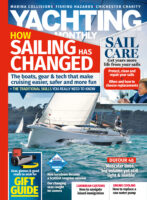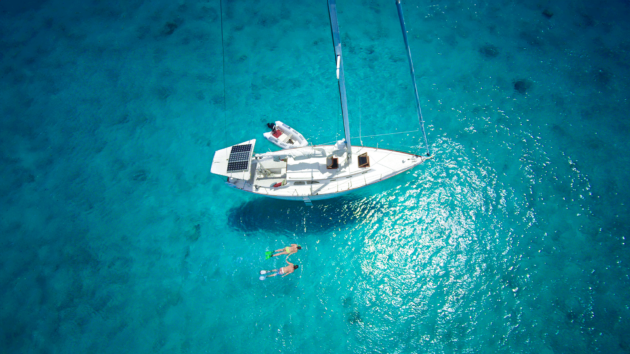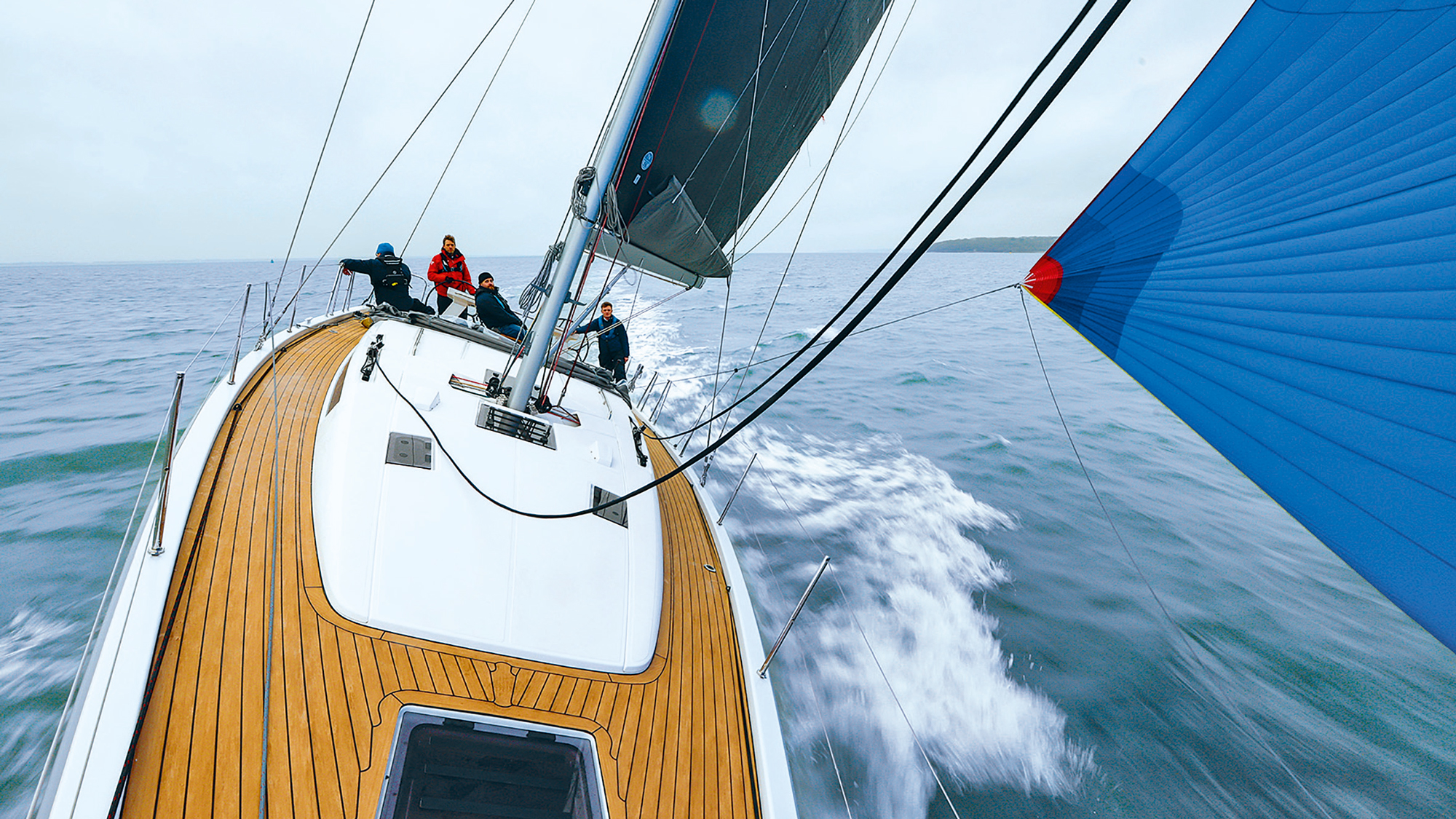Craig Simmons explains how you can reduce your boat's carbon footprint and save money
For nearly three decades, I have been deeply involved in shaping environmental solutions across many industries, from agriculture to aviation. My colleagues and I were even honoured with a prestigious Queen’s Award in 2006 for our groundbreaking work.
Yet, it is only relatively recently that I have begun to apply these lessons to reducing a boat’s carbon footprint – which is somewhat surprising considering that I have been an avid sailor with a passion for all things nautical for almost 50 years. Perhaps I was in denial about the impact my passion for sailing could be having on the marine and global environment?
Empirical investigation for reducing a boat’s carbon footprint
My enquiry into this conundrum started in earnest all the way back in 2013 while I was taking part in the Atlantic Rally for Cruisers (ARC) on a well-equipped 56ft Blue Ocean Lagoon 560 catamaran.
There were nine of us onboard the boat and I calculated that we used 60 litres of diesel on our passage from the Canary Islands across the Atlantic Ocean to St. Lucia, equivalent to just over 6.5 litres per person – a carbon footprint of around 26kg of CO2. That’s similar to driving an average-sized motor car just over 60 miles.
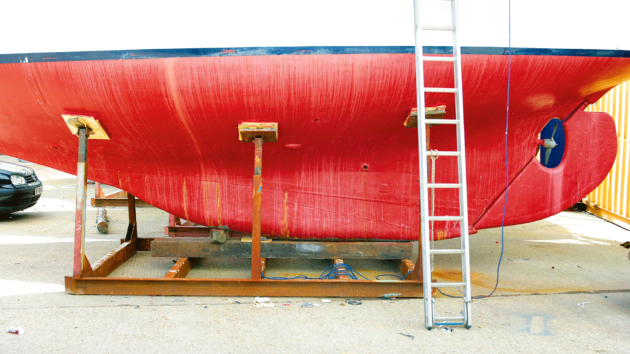
A catamaran doesn’t carry the carbon cost of a heavy cast iron or lead keel. Photo: Andrew Duke /Alamy Stock Photo
I reassured myself that, if I had I flown the same distance, the impact would have been 30 times greater (around 760kg of CO2). But was I deceiving myself? I still had to consider my return flight – and what about the additional wear and tear on the boat?
Prior to the Atlantic crossing, we decided to replace the standing rigging just before we departed, and then ended up blowing out a sail en route. Then there was the boat itself – the materials and energy that went into its production and the eventual impact of its disposal (a growing problem as older GRP boats reach the end of their natural life span).
In this instance, I didn’t actually own the catamaran, so environmental accounting conventions would dictate that any indirect impacts would, fortunately, not appear on my personal ‘environmental balance sheet’. Nevertheless, my interest had been piqued…

Frequent motoring will increase your carbon footprint substantially. Photo: Graham Snook / Yachting Monthly
Seasonal sailing
For most of us, an Atlantic crossing is a rare adventure. A more common scenario is an owner who enjoys seasonal, shorthanded sailing on a modest yacht. I decided to examine the environmental impact and sailing patterns of two hypothetical skippers with different habits over ten seasons:
The owner of a used 10m monohull based, for example, on the South Coast, balancing sailing with other domestic and work commitments. The owner of a new 12m catamaran, who is able to take leisurely annual cruises around the Greek Ionian.

Craig sailed from the Canary Islands to St Lucia aboard a Blue Ocean Lagoon 560. Photo: ESSAI + PALMA 2013
The monohull owner would travel to and from their boat more frequently, often resorting to using their boat’s engine in order to manage time constraints, tides and battery charging. In contrast, the catamaran owner would be more likely to enjoy a single, extended annual cruise, sailing at a relaxed pace with less motoring and ample solar power for house loads.
For simplicity, I focused on estimating the carbon footprint of these scenarios, excluding other impacts such as water, waste and resource use. All these, and the other assumptions made, are summarised in the table below.
Calculation method
To calculate the impact of these two skippers, I used MarineShift360, an online LCA (life cycle assessment) tool created to enable naval architects, boat builders and their supply chain partners to quantify the environmental impact of the products they manufacture and use. It is fast becoming the industry standard for measuring aspects of sustainability, such as the carbon footprint.

Options have never been better for marine-friendly cleaning products
It evaluates the environmental impact during the production, use and end-of-life phases of the different energy sources, materials and components used within a boat.
Boat production
The impact of manufacturing the two boats is similar to what one might expect given the difference in size. The catamaran has a 24 per cent larger carbon footprint (39.0 tCO2e compared with 31.5 tCO2e for the monohull) although the breakdown is quite different for the two boats. Despite using a more modern and efficient lamination process, the catamaran contains more fibreglass and resin than the older monohull.
The monohull, on the other hand, has a weighty cast iron keel absent in the catamaran.
The catamaran’s dual engines are lightweight, modern diesels, so are not as impactful as the more powerful, heavier diesel in the monohull. The rig and sails are proportionately larger in the catamaran reflecting its size and greater complexity.
Article continues below…
6 Tips For Guilt-Free Sustainable Sailing
The social narrative pushes us to take responsibility for protecting the natural environment that we sail in. But how exactly…
Modern (and more sustainable) alternatives to teak decking
The material, colour, and condition of a yacht’s deck can dramatically transform its overall look and feel. Over the years,…
Average annual footprint
The biggest difference arises in the way in which the older, used monohull is accounted for in our scenario. Put simply, the impact of production accrues to the original purchaser as the footprint occurs (the carbon dioxide is emitted) during the boat build. So, when you buy a secondhand boat the production impacts are not ‘transferred’ to you but remain with the original owner.
To put the impact of production into context, the average annual carbon footprint of a UK resident is around 11 tCO2e. In other words, building a yacht is equivalent to the average annual footprint of about three people.
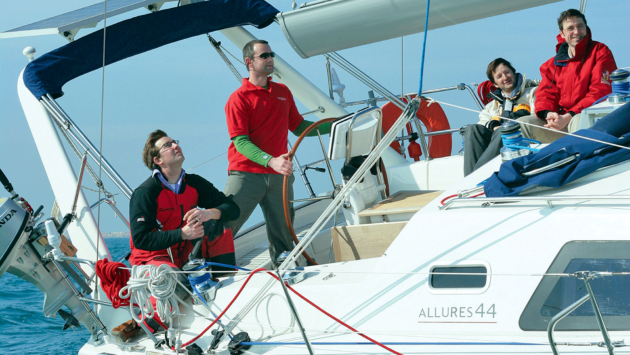
An Allures 44, built with an aluminium hull, sailing off Cherbourg. Photo: Graham Snook / Yachting Monthly
Of course, a yacht is a capital asset and its footprint can’t therefore be compared with that of regular purchases such as food or energy. One common way of looking at capital assets is to amortise the impact of their manufacture across their useful design life. Assuming a 50-year lifespan for a typical yacht, then the annual impact is equivalent to a less shocking 6-7 per cent of a typical annual footprint, less if the yacht is jointly owned.
Builders are increasingly aware of their need to reduce the impact of new boat production. Particularly in Europe, regulations, rising material and energy costs, and pressure from environmentally-conscious consumers is resulting in changing priorities throughout the marine supply chain.
‘New European regulations mean that all boatbuilders will, over the next few years, need to get better at measuring and managing their impacts on the environment and be more transparent in their reporting of these impacts,’ explains Ollie Taylor, Marine Futures’ CEO. ‘And because Europe is such a large market, international suppliers into Europe will need to follow suit.’
Maintenance and use
While our skippers had limited control over how their boats were built, they can control maintenance. Here, we focus on the use of diesel onboard and the impact of travelling to and from the boat over ten seasons.
As expected, flying to the Ionian is more impactful than driving to the South Coast. However, this is largely offset by the greater fuel consumption of the monohull, due to increased daily engine use.
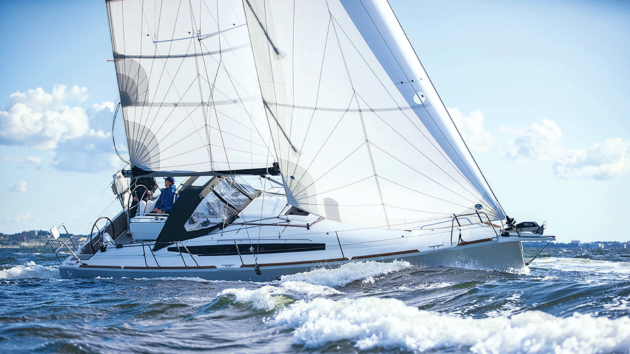
North Sails’ Renew sustainable sailcloth. Photo: Graham Snook / Yachting Monthly
The energy and materials used to repair and maintain each vessel also factored into this use phase estimate. These can vary greatly and are difficult to predict.
A common rule of thumb is to expect to spend 5-15 per cent of a boat’s value each year on maintenance.
If we apply this estimate to the boat’s production carbon footprint (assuming that a percentage of the boat needs maintenance or replacement each year), we get an annual maintenance footprint of around 1.5 tCO2e, or 15 tCO2e over ten seasons.
This rough estimate highlights that ongoing refits and repairs can have an environmental impact nearly as significant as travel and onboard fuel use, potentially surpassing the original impact of production over time.
Top tips for sustainable sailing
The scenarios presented are intriguing as they point to ways in which we can reduce the environmental impact of leisure sailing. Here are some actionable tips applicable to sailors everywhere:
Buy used boats and parts: Purchasing ‘pre-loved’ items avoids the significant carbon footprint associated with manufacture as well as saving money.
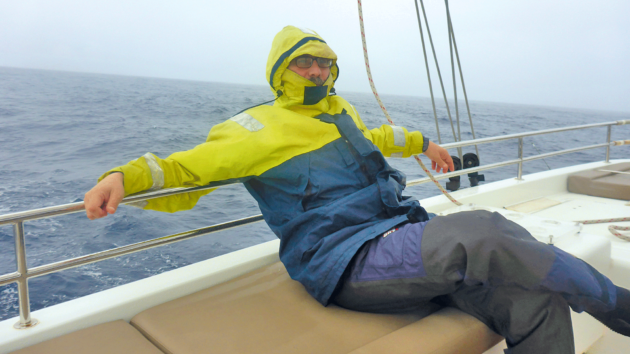
Craig had plenty of time to contemplate carbon calculations on his ocean crossing. Photo: Craig Simmons
Sales of used boats outnumber new boats by around ten to one globally. Boat jumbles are also increasing in size and number, supplemented by online marketplaces where secondhand parts can be sourced. Notably, volume boatbuilders, such as Beneteau, are introducing refurbishment services for older yachts as part of their own sustainability strategy.
Reduce onboard diesel consumption: Propelling a boat through the water takes a lot of fuel, and using your main engine to charge your batteries is inefficient. Slowing down and sailing more can significantly reduce your carbon footprint.
Choose alternative travel methods: Exploring different ways to travel to and from your boat can greatly affect your overall footprint over time. The further
the distance and more frequent the trips, the more critical this becomes. For instance, travelling to the Ionian by rail and ferry, rather than flying, could reduce the impact by more than 50 per cent.
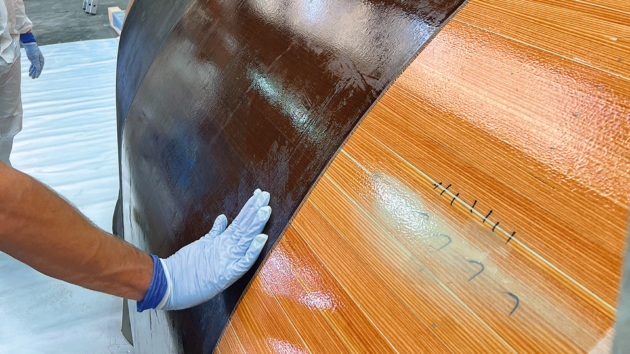
Boat made from flax by Greenboats based in Germany
Maintain your boat: Preventative maintenance is not only cost-effective but also environmentally friendly. Extending the life of your engine, sails and rigging can result in lower overall environmental impact. Regular maintenance helps avoid the need for larger, more resource-intensive repairs and replacements.
Install renewable energy systems: Solar panels, wind turbines and hydrogenerators can help power your boat with renewable energy, reducing reliance on diesel generators and decreasing your overall carbon footprint.
Use eco-friendly products: Whether buying new or secondhand, choose the most environmentally-friendly option. For example, biodegradable cleaning products, eco-friendly antifouling paints, and the use of sustainable or used materials for repairs and upgrades.
Practise responsible waste management: Manage waste onboard properly by recycling and disposing of waste responsibly. Avoid single-use materials and adopt reusable alternatives to minimise marine pollution.
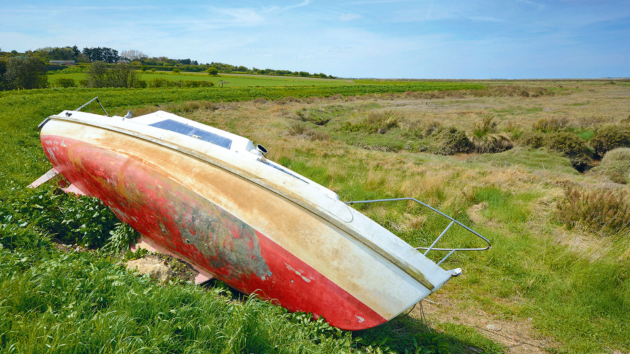
The industry is struggling to deal with ‘end of life’ GRP boats. Photo: Peter Towle
By implementing these tips, yacht owners can enjoy their passion for sailing while minimising their environmental impact. Remember, every small step towards sustainability counts.
The future looks bright for low- carbon yachts, writes Dennis O’Neill
Research by ICOMIA (International Council of Marine Industry Associations) has revealed that the use of sub-24m leisure boats accounts for less than 0.1% of global greenhouse gas (GHG) emissions (see YM 298, February 2024). This may appear negligible but there are now an estimated 50 million recreational craft in existence globally, with around one million new boats being added to that number every year.
The marine industry is therefore focussed on developing innovative new materials that will help reduce boatbuilding’s carbon footprint as much as possible – with plant-based hulls looking to be one of several viable solutions.
Hulls from flax and rock
Flax may soon be the most important future alternative for high-strength composite boatbuilding applications. Lighter than glass strands, but with similar strength and stiffness, flax can be grown from seed to crop in just one hundred days, in all types of soil, with no chemicals and little irrigation required.
The fibres also sequester carbon as they grow, then naturally bio-degrade.
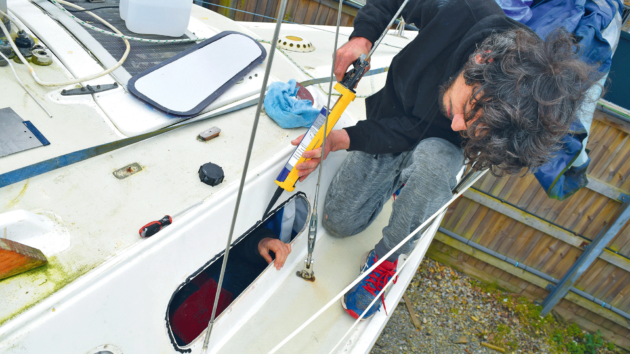
The average annual maintenance of a boat can be responsible for more than a tonne of carbon dioxide
Greenboats has successfully used its attractive Flax 27 daysailer – built with a hull made from flax and a bio-resin – as a test-bed for various natural and recycled materials. The German yard has even developed a way of incorporating NFC (near field communication) chips into the flax to allow the boat’s user or recycler to monitor the material’s condition in anticipation of when it will need to be recycled towards the end of its estimated 30-year lifespan.
Another increasingly used alternative to GRP is basalt, derived from volcanic rock. Catamaran manufacturer Windelo now uses basalt fibres and a recycled PET foam core in the production of its range of catamarans.
Recycled aluminium
While many racing dinghy hulls are now made from recyclable polyethylene, a growing consideration for the construction of cruising yachts is to use wood composite or aluminium hulls – materials that can be recycled and that don’t require moulds. Vaan Yachts in the Netherlands, for instance, now builds catamarans from recycled aluminium, giving a second life to old window frames, traffic signs and even number plates.
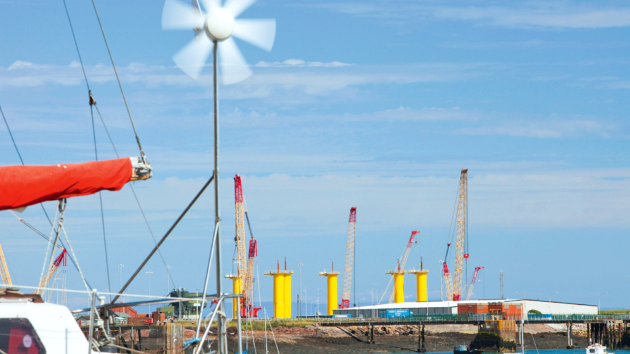
Renewable energy systems will reduce your need to use fossil fuel. Photo: Construction Photography/Avalon
Sail power
Laminate sails with a Mylar membrane can’t be recycled, so many used sails go to landfill, or are simply abandoned. Polyester/Dacron sails are largely thermoplastic so can be melted and reformed. However, other than turning them into bags or accessories, what are the options for sails that have synthetic fibres
and high modulus yarns which are notoriously difficult to chop up and repurpose?
OneSails is leading the way in this field with its high-tech 4T technology that uses a recyclable base polymer to avoid using Mylar, making it a fully recyclable single structure sail. ‘It’s the only genuine sailmaking system that offers the opportunity for sailors to recycle their “end of life” sails,’ explains OneSails UK’s John Parker.
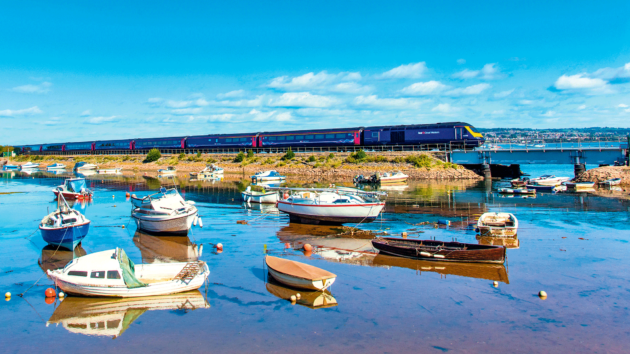
The way you choose to travel to your boat will significantly affect your carbon footprint. Photo: Paul Martin / Alamy
North Sails, meanwhile, has launched a new sailcloth, RENEW, designed for cruising boats from 25ft to 45ft, that’s constructed from 90 per cent sustainable materials, with, the company claims, no sacrifice in performance or longevity. The sailmaker says it uses an extensive network of fabric suppliers to ensure that all of the material used in RENEW has been sourced from recycled polyester and bio-based Dyneema.
The highly durable laminate used to make RENEW is guaranteed to be compliant to the strict standards set out by the ISCC (International Sustainability and Carbon Certification) and international Bluesign sustainable textile standards.
MarineShift360
MarineShift360 is a user-friendly and free (for most users) life cycle assessment (LCA) tool that simplifies the complexities of sustainability calculations for boatbuilders, equipment suppliers and yacht owners to help them quantify the true environmental impact of their products and operations.
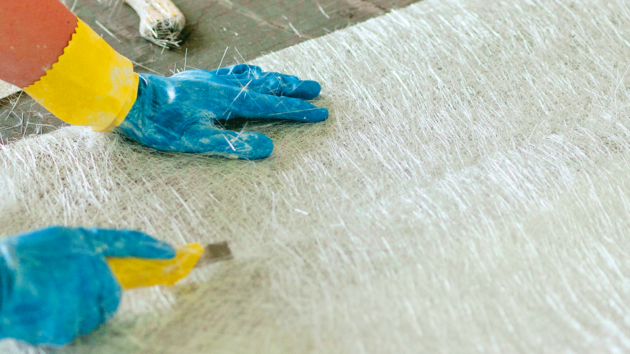
Building one GRP yacht is equivalent to the annual footprint of three people. Photo: Borislav Dopudja / Alamy Stock Photo
Used by many companies, associations and institutions within the marine sector, MarineShift360 follows international accounting rules and standards for life cycle assessment. It is widely used by IMOCA-class yacht racing to inform specific rules focused on limiting the impact of new-build Open 60s.
It measures a range of environmental impacts, not just the carbon footprint, and is managed by Marine Futures with support and funding from ocean charity 11th Hour Racing. More at www.marineshift360.org.
Enjoyed reading this?
A subscription to Yachting Monthly magazine costs around 40% less than the cover price, so you can save money compared to buying single issues.
Print and digital editions are available through Magazines Direct – where you can also find the latest deals.
YM is packed with information to help you get the most from your time on the water.
-
-
- Take your seamanship to the next level with tips, advice and skills from our experts
- Impartial in-depth reviews of the latest yachts and equipment
- Cruising guides to help you reach those dream destinations
-
Follow us on Facebook, Twitter and Instagram.
Note: We may earn a commission when you buy through links on our site, at no extra cost to you. This doesn’t affect our editorial independence.

